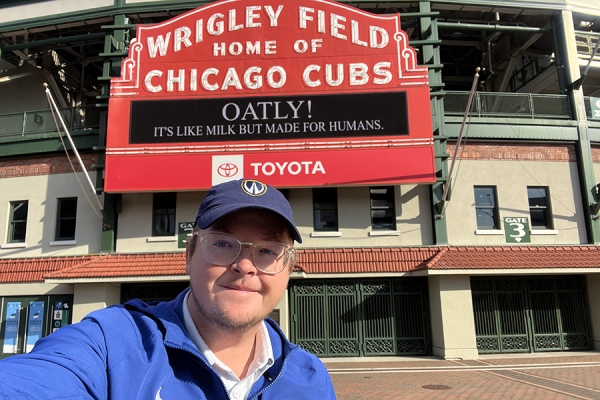 Mike Sonne’s expertise in biomechanics, paired with his love of baseball, has landed him a job as the Chicago Cubs’ new baseball scientist.
Mike Sonne’s expertise in biomechanics, paired with his love of baseball, has landed him a job as the Chicago Cubs’ new baseball scientist.
UWindsor alum Mike Sonne has always been a baseball guy.
He plays baseball. He coaches baseball. He’s a fan.
But recently, Dr. Sonne went from being just any baseball guy to being the baseball guy, snagging a job with the Chicago Cubs as the major league club’s new baseball scientist.
What’s a baseball scientist?
“Everyone asks that,” said Sonne.
Sonne uses his expertise in biomechanics to figure out how hard a player can work before performance diminishes or injury is inevitable.
“The idea is to optimize performance,” he explained. “I look at how safely we can get our players on the field performing at their maximum for as long as possible.”
Sonne is part of the Cubs’ research and development department. Without giving too much away, Sonne said the size and scope of the Cubs’ tech team rivals that of any start-up in Silicon Valley. The department collects data on every player in the franchise — from the Cubs’ starting pitcher to young hitters on the club’s farm teams. It collects data on players from rival teams, too.
Sonne takes all that data and runs it through a model he originally designed to predict muscle fatigue in automotive assembly-line workers.
“My job is to figure out how to translate this data into actionable items.” Using a pitcher as an example, Sonne said he can go to the coach and say, “Get this person on the mound more, or maybe they need to skip a start.”
Sonne says there’s no magic to what he does — you just need to know what to look for.
“When you have a good understanding of how muscles fatigue, you can see subtle changes in movement patterns,” he said.
Comparing what he sees to the data collected, he can predict when players need rest to get back at the top of their games.
Sonne, 39, said he never dreamed of becoming a baseball scientist.
“I don’t think my dreams were ever so audacious to think this was possible.”
He graduated from Belle River high school intent on studying music.
“My guidance counsellor told me if I took kinesiology, I could only be a gym teacher,” he said wryly.
After completing his bachelor’s degree in human kinetics, he worked for two years as an ergonomist in Ottawa and Michigan before returning to UWindsor for master’s studies. During grad school, he worked with kinesiology professor Dave Andrews researching the body movements of assembly-line workers in the automotive industry.
“I definitely loved the HK program there,” he said.
For his PhD, he attended McMaster University and conducted further research on autoworkers with former UWindsor professor Jim Potvin.
Throughout his time at UWindsor, Sonne was the trainer for the Lancers football team. A helmet the team gave him when he graduated remains on display in the bedroom of his Hamilton home.
As part of this UWindsor master’s education, Sonne did an internship with an ergonomics tech company. When the company later folded, Sonne started his own.
His company allowed clients to use cellphones to analyze joint angles to improve ergonomic design. After completing his doctoral degree, Sonne worked for the Occupation Health Clinics for Ontario Workers in Hamilton.
He started blogging about sports, applying his expertise on forces, posture, and repetition to what professional baseball players do. Among other topics, he wrote about how the introduction of a pitch clock would put major-league pitchers at higher risk of injury.
“I ended up getting a pretty significant social media presence,” he said.
Sports sites and publications such as Fangraphs and The Athletic approached him about becoming a freelance writer. That led to an article in Sports Illustrated.
Then came a call from Craig Breslow, assistant general manager of the Chicago Cubs and a former Major League Baseball pitcher himself.
Breslow brought Sonne in for a team education seminar. Afterwards the two men exchanged texts about a possible role with the club.
They inked a deal in October.
Sonne spends some time at Wrigley Field each month, but spends most of his time on the road, visiting farm teams in Iowa, Tennessee, and South Carolina.
Hamilton, where Sonne is a player-coach with the Steel City Inclusive Softball Association, will remain his home base.
His parents, Patsy and Brian, still live in Windsor, a place he called home from the time he was seven.
Like when he was a boy, he revels in the magnificence of the game.
“I’m always amazed when I watch a pitcher throw,” he said. “They are so outside normal human function…. It’s a beautiful celebration of what can go right with the human body.”
—Sarah Sacheli
